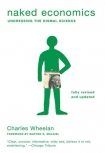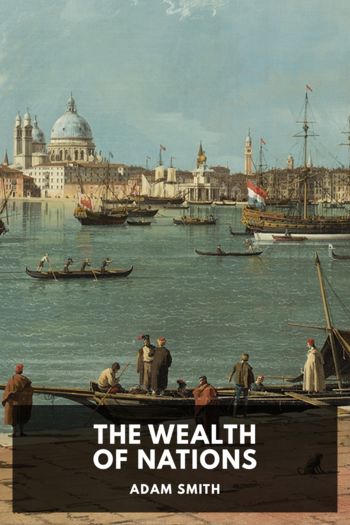Naked Economics, Wheelan, Charles [open ebook .txt] 📗

Book online «Naked Economics, Wheelan, Charles [open ebook .txt] 📗». Author Wheelan, Charles
We don’t really care about currencies per se; what we really care about is the underlying flow of goods and services. These trades across international borders are what make us better off; currencies are merely a tool for facilitating mutually beneficial transactions. In the long run, we would expect the value of the goods and services that we send to other countries to be more or less equal to the value of what they send to us. If not, someone is getting a really bad deal. Even little kids trading snacks in the lunchroom recognize that what you give up should be worth what you get back.
Except for the United States. We’re the guys in the lunchroom giving up liverwurst sandwiches and getting a turkey sandwich, plus chips, cookies, juice, and a peanut-free snack. The United States has been running large and persistent current account deficits with the rest of the world, meaning that year after year we are getting more goods and services from the rest of the world than we sell to them. (The current account measures income earned abroad from trade in goods and services, plus some other sources of foreign income, such as dividends and interest on overseas investments as well as remittances sent home by Americans working abroad.) How are we getting away with that? Might it be a problem in the long run? The answer to the second question is yes. The first question is more complicated.
As noted in Chapter 9, there is nothing inherently bad about a current account deficit, nor anything inherently good about a current account surplus; countries like Algeria and Equatorial Guinea were running current account surpluses in 2007, but that does not make them economic powerhouses. Still, there is an unavoidable economic reality lurking here: A country running a current account deficit is earning less income from the rest of the world than it is paying out. Consider a simple example: If we buy $100 million in cars from Japan and sell them $50 million in planes, then we’ve got a $50 million current account deficit. The Japanese are not sending us an extra $50 million in merchandise because we’re friendly and good looking; they expect us to make up the difference. To do that, we have only a couple of options. One option is to sell our Japanese trading partners assets instead—stocks, bonds, real estate, and so on.
For example, we might sell Japanese firms $25 million in Manhattan real estate and $25 million of equity in American firms (stocks). Now the ledger makes sense. Americans get $100 million of goods and services from Japan; in exchange, we send over $50 million in goods (the planes), and another $50 million in assets. That’s an even deal. It comes with a price, however; the assets that we’re giving up (real estate and stocks) would have generated income for us in the future (rents and dividends). Now that income will go to our trading partner instead. We’re buying cars now by giving up future income.
That’s not our only choice. We can buy our merchandise on credit. We can ask some willing party in the global financial community to loan us $50 million. In that case, we “pay for” our $100 million in Japanese cars with $50 million in planes and $50 million in borrowed capital. That, too, has obvious future costs. We have to pay back the loans, with interest. Again, we are paying for current consumption by borrowing against the future—literally in this case.
Why is the United States running chronic current account deficits? It has virtually nothing to do with the quality of our goods and services or the competitiveness of our labor force, as conventional wisdom would have it. (To my earlier point, do you think Algeria and Equatorial Guinea are running current account surpluses because they are producing better stuff with more productive workers?) The United States is running chronic current account deficits because year after year we are consuming more than we produce. In other words, we are doing the opposite of saving (in which you produce more than you consume and set the extra aside). As a nation, we are literally doing what economists call “dissaving.”
The connection between the current account balance and a nation’s savings rate is crucial. Any country that is consuming more than it produces must by definition be running a current account deficit because (1) the stuff you are consuming beyond what you produce must come from somewhere else in the world; and (2) you can’t trade goods and services for the extra stuff that you’re getting from the rest of the world because you’ve consumed everything you have.
As usual, a farming analogy will help. Suppose Farmer America grows corn. He is a highly productive farmer, handsome and smart, who uses only the most modern farming techniques. (These details are irrelevant here, just as they are when describing whether a national economy runs a current account surplus or deficit.) There are only four broad things that Farmer America can do with what he grows: He can eat it (consumption); he can plant it for next year’s crop (investment); he can send it to the government to pay for services (government spending); or he can trade it for other stuff (exports traded for imports). That’s it. So let’s imagine that Farmer America’s year looks like the following:
He grows 100 bushels of corn. He eats 70. He sends 30 to the government. He needs 20 to plant next year. But if you do the math, you’ll see that Farmer America is using 120 bushels a year but growing only 100. He must be a net borrower of corn—20 bushels in this case. That is the equivalent of a current account deficit, and it’s just math—if he uses more corn than he grows, the rest has to come from somewhere else.
Farmer China works across the way. He grows only 65 bushels of





Comments (0)